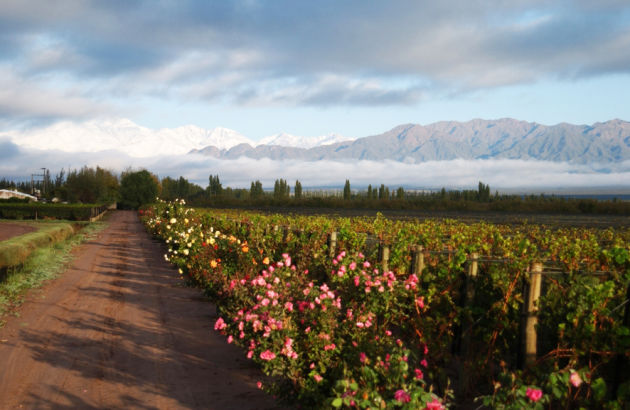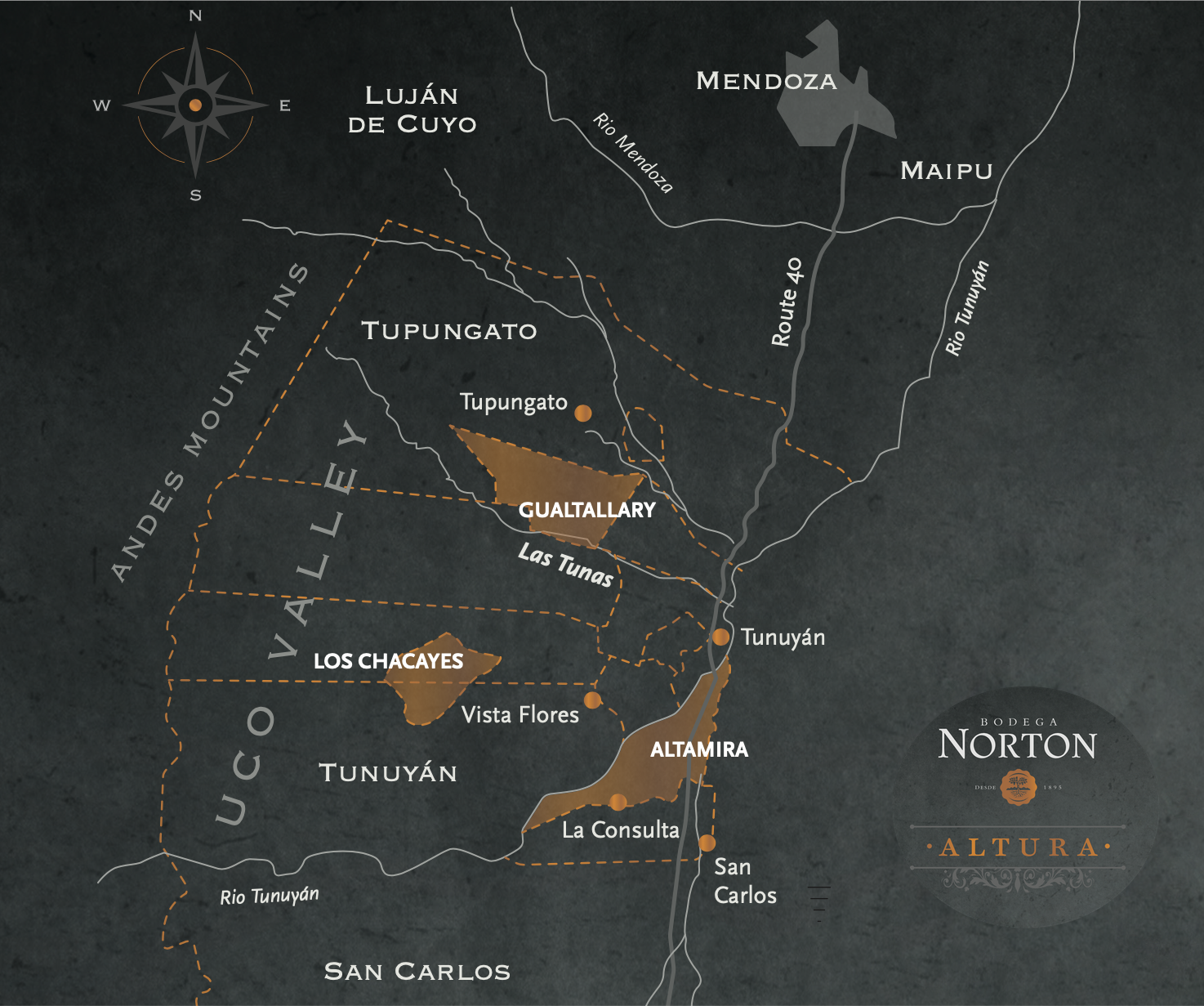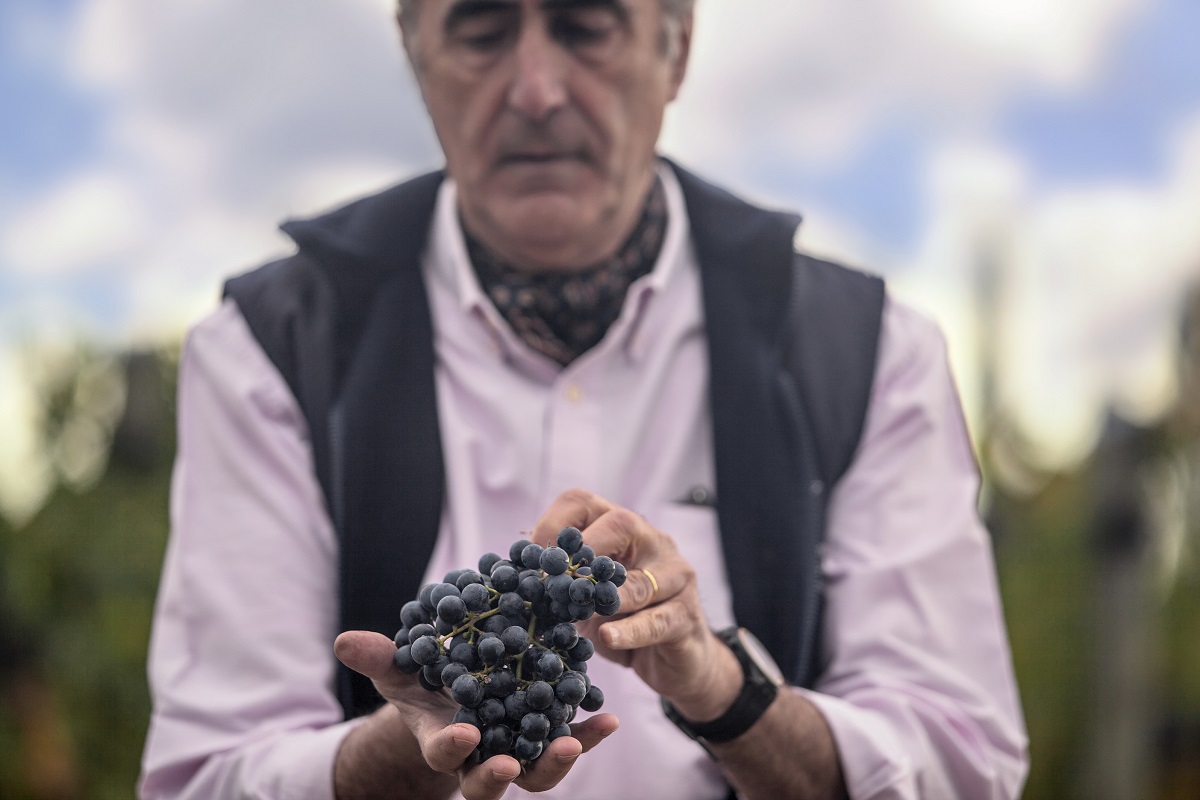
Friday read: Latitude, altitude and attitude – the quest for balance and personality in Argentina
Bodega Norton and Viñalba have both played key roles in Argentina’s vinous revolution, helping to establish the country as a beacon of quality and price on the world stage. Through the lens of these two Mendonza wineries in both Uco Valley and Luján de Cuyo, Jo Gilbert charts how the country got to where it is today, and how a new wave of winemakers are heading outwards to explore Argentina’s terroir.
Argentina has been on a roller coaster over the past thirty years. Centuries after the Spanish got things moving with the now out-of-favour Criolla, the country burst onto the export market in the 1990s, where it quickly came to rival (and in many ways overtake) Chile as South American’s hero region, largely thanks to the runaway success of Malbec.
And the story doesn’t end there. Today, Malbec still dominates. At somewhere like Viñalba, which was at the forefront of establishing single varietal Malbec globally, it accounts for 80% of production. Despite its French roots, Malbec has become Argentina’s most constant and winning ambassador, bringing the country plaudits and a reputation for wines with value-for-money-meets-swag.
But as time goes on and this country continues to push quality upwards, winemakers are becoming more and more attuned to Argentina’s place as the sixth largest volume producer of wine worldwide, and the challenges that come with supplying a global palate.
That this is propelling them to ever greater extremes to not only find balance in the wines but also a sense of place (all while satisfying the bottom line) was evident at last month’s Wine of Argentina’s Barullo session.
Because Argentina’s extremes are not the rest of world’s extremes. It is a place of extreme beauty underpinned by large temperature swings, from the cooling influences of the Andes in the north and flats of Patagonia not far from Antarctica helping to offset an overall warm climate. But the trade-off is hail the size of cricket balls and frost that can very easily decimate crops.
For many, the likes of David Bonomi, chief winemaker at Bodega Norton, are the face of this “New Argentina”.
Born in Mendoza, the winemaker is of Italian winemaker stock, and has been focused on producing fresh, high altitude wines since joining wine the 125-year-old winery in 2002.
There was a stint at Doña Paula, also in Mendoza. But since his return to Bodega Norton as chief winemaker 2014, he has been going to greater lengths in his mission to find the perfect match of vineyard to grape variety by pushing further upwards as well as outwards to Patagonia and Salta.
Working across 160 different plots stretched over a 4,000km stretch of land can’t be easy.
But, he says, both latitude and altitude have been vital to his “new vision” for winemaking.
“Sixty years ago, vines were being grown between 700m and 1000m. Today, the most exciting projects are the ones higher up,” he told Harpers.
“In Mendoza, for every 100m you go up, the temperature reduces by 1.5 degrees, which is a big difference. There is a lot of variation. The Torrontes we make in Salta is completely different. It’s much warmer compared to Mendoza. Then in Patagonia, the influence isn’t the altitude, it’s Antarctic conditions – frost and snow. It’s all about maintaining balance with the place and the winemaking process.”

Bodega Norton Uco Valley map
Bodega Norton isn’t the only winery pushing the envelope to make balanced wines that satisfy the zeitgeist for wines that show a sense of place.
Both Bodega Norton and Viñalba are based in the Uco Valley and, to the north of the region, Luján de Cuyo which are both at the upper viticultural limit in terms of altitude in Mendoza.
They are also both making wine in Gualtallary in Tupungato, one of the highest points in the region, sitting at about 1,600m.
Because of its elevation and influence of the Tunuyán and Tupungato rivers on the soil type, Uco Valley has attracted a wave of producers in recent years, both internationally and from second-generation Argentinian winemakers. As a result, the area under vine has nearly doubled in the last decade from 12,235ha to 23,393ha.
The Viñalba property is currently one of the highest and the largest in Uco Valley with 3,500ha (a mixture of planted and unplanted) between 1200m and 1550m and an additional 30ha being planted every year. Experimentation is going into blended parcels of Malbec and other grape varieties at these extreme elevations, but always with an eye for what will work at home and on the export market.
“It’s all about maintaining balance and a commercial enterprise,” says owner and director Diane Joyaux Fabre. “Too low and you get frost. Too high and the grapes won’t ripen. High altitudes also mean you have to use low yields to reach the required ripeness, therefore your wines will be more expensive.
“You need to go relatively high for freshness, but we won’t go above 1,600m because it’s trendy. We plant where we get optimum maturity and where it’s the best expression of the terroir.”
Chief winemaker David Bonomi, Bodega Norton
In the winery
So far, this is the story in the vineyard. In the winery, on-going efforts are being made to preserve the results à l’extérieur and transfer them to the bottle.
At Bodega Norton, parts of the winery are set up to subvert past conventions where the approach to “intervention was completely different – a lot of chemicals”.
“I have the knowledge,” says Bonomi, “but I prefer natural conditions. Natural yeasts are very important and I don’t use sulphur for the first part of the ageing process. Whether I filter or not, when you drink the wine it’s absolutely natural.”
This is the case with the estate’s new Norton Altura range which was created with these philosophies in mind.
Inspired by the connection between “soil, altitude and the microclimates” of Uco Valley, cold maceration and fermentation in small concrete vats are used to maintain the fruit characteristics and forms part of a wider hands-off approach.
“For years, my main criticism of Argentinian wine was that it was all a copy,” said Bonomi. “Some might be oakier, have more concentration, or more alcohol than others, but you couldn’t get a feel for the place. Today, my energy and knowledge goes into matching the most pure varietals with the place.”
One of the more interesting things to emerge from this evolution might be the on-going efforts to re-imagine and expand the potential of white wines.
Last year, Viñalba experimented with small parcels of barrel-fermented Torrontes at 1,400m.
It is currently available via Buckingham Schenk in small quantities. But Joyaux Fabre believes a future at the premium end might be possible.
“The Torrontes is amazing up there: very high altitude, low yields, but freshness which is so delicate and elegant.
“The great thing about having such a big property is the freedom to plant different varietals. We also have parcels of Cabernet Franc, which is usually used as a blending partner for Malbec, but maybe we will look at single varietal next. The freshness and typicity is amazing,” she said.
Bonomi has also been on a drive to update the style of Bodega Norton’s whites, including Norton’s Reserve Chardonnay.
This has moved from an oaky style, aimed more at the US market, to something which is “picked earlier for freshness” and undergoes no malolactic fermentation.
In past years, achieving both the complexity and freshness for the whites was a struggle, Bonomi said. Now however, wines like their Norton Altura White Blend made from Sauvignon Blanc, Semillon and Grüner Veltliner has been made possible with careful site selection and – in the case of Semilion – concrete eggs to maintain the primary fruits.
Grüner Veltliner is of particular significance to Norton.
It’s part of the estate’s heritage having been brought over from Austria by the Swarovski family when it bought the estate in 1989.
Michael Halstrick, great-great-grandson of the diamond dynasty’s founder, still owns the estate.
When Bonomi re-joined in 2014, as part of a “new vision” for the whites, he pushed to plant the grape in three new places, including Patagonia, to make the most of what he sees as the grape’s versatility.
He said: “Grüner in Austria is similar to Malbec in Argentina in that it can develop different styles depending on the altitude. The acidity for Grüner is amazing, but we use no more than 15% in this blend.
Gualtallary Viñalba
“The most important variety however, is Sauvignon Blanc. A lot of effort goes into developing it in our warm climate. But with altitude you get a very nice citrus note from the thiols, which I prefer. For years, Argentina made more tropical styles of Sauvignon Blanc, but today, it is moving more to the middle towards citrus and away from green and tropical. In the middle, there’s more freshness and more possibility for people like the wines.
“In our country it is very important to maintain freshness.”
But despite new plantings, this “isn’t the end of the story for Malbec” says Joyaux Fabre, whose husband, Bordeaux winemaker Hervé Joyaux Fabre, moved the family from France to Argentina in the 1990s.
“The trend for Malbec is still there. The next step is experimenting with altitude and blending different Malbec parcels from different points on the estate.
“We’re planting more Cabernet Franc, which has this fantastic peppery vibrancy, and Touriga Nacional. We probably have some of the highest Touriga Nacional in the world,” she said.
Viñalba has also launched a Malbec Rosé which is now in its second vintage.
As one of the top ten suppliers to the UK in terms of volume, (the UK is the biggest export market for Viñalba), with 200,000 cases a year to the UK, keeping a keen eye on trends is key.
“The great thing about Argentina is we can ship straight to UK. As the harvest finishes in May, the UK can be drinking 2020 rosé in summer 2020.”
Bonomi’s quest to make wines that show a sense of place has taken him from north to south. For Viñalba, the Joyaux Fabre clan continues to experiment and push the boundaries at their Mendoza estate.
There are plenty of others, with Zuccardi, Catena Zapata, Chacra just a handful of names in Mendoza and beyond showing that Argentina wines can stand among the world’s best.
For Argentina, there is plenty of scope left to explore both upwards and outwards.
Diane Joyaux Fabre sums it up when she says, “Winemaking is all about adapting to the product you have. Every year, it’s never the same recipe. You have to interpret grapes – like a Michelin-starred chef, have to use feeling and talent. It’s an on-going process.”

Hervé Joyaux Fabre
Top photo shows vineyards at Bodegas Fabre in Luján de Cuyo
Keywords:
- UK
- US
- Argentina
- malbec
- Mendoza
- Wines
- Sauvignon Blanc
- Viñalba
- it’s
- uco valley
- place
- different
- joyaux fabre
- norton
- export market
- altitude
- bodegas norton
- plant different varietals
- bodegas norton’s whites
- including norton’s reserve
- whites including norton’s
- norton’s whites including




